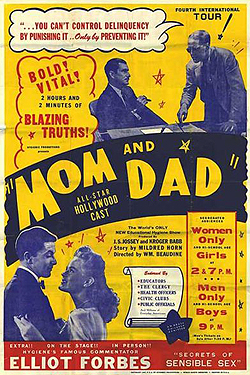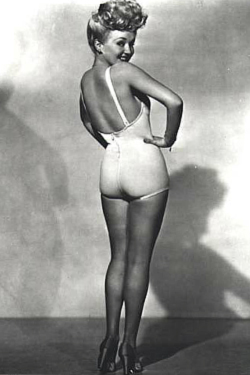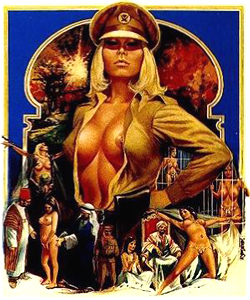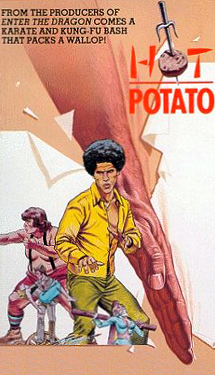
Welcome to Sewer Subterranea.
Before I write anything about any film, I’d like to shout up to Nick Nunziata, Devin Faraci, Russ Fischer, Micah Robinson (holy bleeding hell were you right about The Source), and the rest of the staff at CHUD for letting me play in their park.
Also, I’d like to give thanks to one Dave Davis, whose Dave’s Underground is not only a fairly obvious inspiration – it casts a ruthless shadow over anything I’ll write about any film we watch.
I’d actually bandied the notion of this column about for a couple years, but feared I’d not be able to keep up with the obviously grueling CHUD pace. At any rate, here we are – and just in the nick of time.
I don’t want to rent real estate on 42nd Street forever – I think our journey will eventually take us all over the place – but I will acknowledge that some of the films we?ll be discussing are part of the grindhouse tradition.
Ahh…”in the nick of time” – it all becomes so clear…
Let?s all go to the Grindhouse?
 I’ve found myself explaining to many people exactly what “Grindhouse” means of late, and so – for those who’ve just joined us – an “explo-nation”:
I’ve found myself explaining to many people exactly what “Grindhouse” means of late, and so – for those who’ve just joined us – an “explo-nation”:
Due to a perceived sheen of sordid scandal in Hollywood, the Motion Pictures Producers and Distributors Association (later rechristened the Motion Picture Association of America) was formed in 1922. With the onset of the “talkies”, the Production Code (or “Hays Code”) was adopted.
Will Hays was a one-time U.S. Postmaster General tasked with putting an “upstanding” face on the film industry. He attempted this through the creation of the Production Code – a set of rules filmmakers had to follow in order to insure that their projects would pass muster in the eyes of a perversely puritanical America. History illustrates that this was basically an attempt to pay lip service to moralists, stave off Government intervention and censorship, and force into obsolescence the censorial intuitions that had cropped up in many states. We see a similar thing happening today with video games – create a watchdog group before one gets created for you.
Still, the studios capitulated for the most part – and that’s where the fun begins.
Self-styled MORALISTS Would Like to Keep These Facts a Secret!
 In Hudson Hawk (I know – I’m reaching), Danny Aiello’s Tommy Five-Tone explains the lure of crime thusly, “I never wanted a cigarette until I saw my first ‘No Smoking’ sign. Keep Off The Grass? Let’s play soccer!” Similarly, once the Production Code spelled out what couldn’t be shown, many a filmmaker saw an opportunity to make real profits showing just that – and a cadre of canny carnie con artists realized that if the studios had to play ball with Hays, they certainly didn’t. Thus began the rise of the Forty Thieves.
In Hudson Hawk (I know – I’m reaching), Danny Aiello’s Tommy Five-Tone explains the lure of crime thusly, “I never wanted a cigarette until I saw my first ‘No Smoking’ sign. Keep Off The Grass? Let’s play soccer!” Similarly, once the Production Code spelled out what couldn’t be shown, many a filmmaker saw an opportunity to make real profits showing just that – and a cadre of canny carnie con artists realized that if the studios had to play ball with Hays, they certainly didn’t. Thus began the rise of the Forty Thieves.
The Forty Thieves were pirates of the celluloid seas. Most of them weren’t filmmakers, but distributors – armed with a ruthless knowledge of how the business end of things worked. The Theives carved out territories, took a few filmic oddities on the road from town to town – most notably Howard “Kroger” Babb’s Mom and Dad (which promised a look at the miracle of birth, but also featured footage of extreme STD cases) and Child Bride (supposedly a treatise against mountain men marrying minors – with a nude scene featuring a twelve year old actress) – and generated around them an aura of wanton morality and danger. Danger. Danger.
The idea was to promise town leaders that the film contained a “strong moral message”, while promising curious thrill-seekers that they might see some semblance of fornication (or at least a booby). Everyone left mostly unfulfilled – with the exception of the Thieves (though, since Mom and Dad features a live birth – it also feature a live vagine, so maybe everyone did go home happy). Their four-walled extravaganzas yielded absurd money – Joe Bob Briggs’ Profoundly Disturbing cites speculation that Mom and Dad alone made somewhere in the area of $100,000,000.
Nudie-Roughie-Kinky-Spookie
 The roadshow wouldn’t last forever. Post-World War II, many males didn’t need to see a poorly-mounted morality tale about syphilis – they had dodged it like they dodged bullets in the European Theatre of Aggression. Add to this the fact that the “pin-up” became downright patriotic (who among us hasn’t seen Betty Grable’s famously-posed posterior) and it was clear that Hygiene films and Nudist romps were irrelevant – why not put a burlesque bump-and-grind act on film?
The roadshow wouldn’t last forever. Post-World War II, many males didn’t need to see a poorly-mounted morality tale about syphilis – they had dodged it like they dodged bullets in the European Theatre of Aggression. Add to this the fact that the “pin-up” became downright patriotic (who among us hasn’t seen Betty Grable’s famously-posed posterior) and it was clear that Hygiene films and Nudist romps were irrelevant – why not put a burlesque bump-and-grind act on film?
This spawned the “Nudie Cutie” where filmmakers like Doris Wishman made titillation good-natured fun…which begat the “Roughie” – where a girl was probably going to be treated, well – roughly…which spawned the “Kinky” – chock full of S&M and bondo…
In the late forties, an anti-trust lawsuit killed the notion of the studios owning theaters (didn’t it?), and independents picked up the slack. “Art Houses” were on the rise as World Cinema poured onto our shores. And while And God Created Women and I am Curious (Yellow) – not to be confused with I am Curious Black – sought to broaden what was permissible with regards to sexuality on cinema screens (the Production Code was abandoned in 1968), “Nudie” pioneer Herschell Gordon Lewis and “Kroger” Babb protetge David Friedman were testing the boundaries of cinematic violence with Blood Feast, Two Thousand Maniacs, and The Wizard of Gore (“Old hat, you sayyy?”).
In the Apple, on the Deuce
 On New York City’s 42nd Street, urban decay had turned Oscar Hammerstein’s once-lavish theaters into raincoat recreation rooms – porno and z-grade fare ruled the Deuce by the seventies. The run-down theaters were grinding out movies almost non stop, and anything would do. Italo-splatter, biker flicks, women in prison movies (notably the Ilsa series) and low-budge slashers thrived in these environs. Black cinema got its first shot in the arm right about this time, as Melvin Van Peebles’ Sweet Sweetback’s Baadasssss Song (with an ad campaign that told you, as Kroger Babb did decades before, that the establishment didn’t want you to see it) paved the way for Super Fly, Lord Lawrence Cohen’s Cotton Comes to Harlem and Hell Up in Harlem, and Rudy Ray Moore’s classic Dolomite. Bruce Lee hit the states with “KARATE/KUNG FU!” (yeah – they’re the same thing…) in Fists of Fury – which created a sudden excitement for martial arts movies, and had many an urban-dwelling African-American male wearing “gentlemen’s shoes” (the demented 1985 cheese-fest Berry Gordy’s The Last Dragon stands as a oddball remembrance of that bit of cultural weirdness). Combine chop-socky with blaxploitation (wouldn’t you have to?) and you got Black Belt Jones (and the follow-up, Hot Potato – both vehicles for Enter the Dragon‘s Jim Kelly).
On New York City’s 42nd Street, urban decay had turned Oscar Hammerstein’s once-lavish theaters into raincoat recreation rooms – porno and z-grade fare ruled the Deuce by the seventies. The run-down theaters were grinding out movies almost non stop, and anything would do. Italo-splatter, biker flicks, women in prison movies (notably the Ilsa series) and low-budge slashers thrived in these environs. Black cinema got its first shot in the arm right about this time, as Melvin Van Peebles’ Sweet Sweetback’s Baadasssss Song (with an ad campaign that told you, as Kroger Babb did decades before, that the establishment didn’t want you to see it) paved the way for Super Fly, Lord Lawrence Cohen’s Cotton Comes to Harlem and Hell Up in Harlem, and Rudy Ray Moore’s classic Dolomite. Bruce Lee hit the states with “KARATE/KUNG FU!” (yeah – they’re the same thing…) in Fists of Fury – which created a sudden excitement for martial arts movies, and had many an urban-dwelling African-American male wearing “gentlemen’s shoes” (the demented 1985 cheese-fest Berry Gordy’s The Last Dragon stands as a oddball remembrance of that bit of cultural weirdness). Combine chop-socky with blaxploitation (wouldn’t you have to?) and you got Black Belt Jones (and the follow-up, Hot Potato – both vehicles for Enter the Dragon‘s Jim Kelly).
 In the Midwest, Drive-Ins did double and triple bills akin to the B-Movie fare found in the grindhouse theaters. I remember reading the newspaper as a small child and coming across a story of motorists in a collision after getting an eyeful of bustiness while driving past Gary, Indiana’s old Y&W Drive-In. A few years later I saw a triple feature of Re-Animator, Texas Chainsaw Massacre 2, and (the utterly abysmal) Bloody Birthday there. It was the last bill I’d ever take in at the Y&W.
In the Midwest, Drive-Ins did double and triple bills akin to the B-Movie fare found in the grindhouse theaters. I remember reading the newspaper as a small child and coming across a story of motorists in a collision after getting an eyeful of bustiness while driving past Gary, Indiana’s old Y&W Drive-In. A few years later I saw a triple feature of Re-Animator, Texas Chainsaw Massacre 2, and (the utterly abysmal) Bloody Birthday there. It was the last bill I’d ever take in at the Y&W.
Video had taken a firm foothold, and many of the exploitation films that managed run after run on the grindhouse circuit (with multiple titles and cuts, of course) – not to mention hardcore porn – thrived on cassette. Why risk a mugging (or spray the inside of a poncho with man-milk) when you could rent the flick and watch it in the privacy of your own home instead?
In the late eighties, NYC’s grindhouses found themselves under attack by then mayor Ed Koch in a bid to rid the city of its creepier element. I watched a lot of WOR Super Station broadcasts out of NYC during that time, and I firmly believed Koch was one of NYC’s creepier elements. He seemed like a guy who’d have been right at home watching Messalina, Messalina! in a dilapidated theater at 3:00AM sandwiched between two guys on PCP (which, you will learn very soon, has many different names. Or three). By the time Adolp- er, Rudolph Giuliani got through with Times Square everything had changed, and the grindhouse experience was relegated to tales told by guys who made those films, and guys who loved them.
When next we descend, we’ll take a look at some of the grindhouse films that inspired the Grindhouse film.
CHUD?s Sewer Subterranea wants your films!
Sewer Subterranea
PO BOX 967
Chesterton, IN 46304
E-Mail Sewer Subterranea
Visit Sewer Subterranea at MySpace